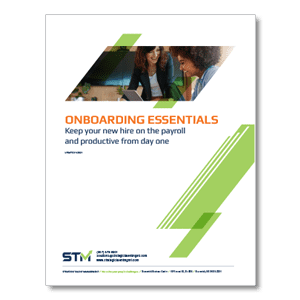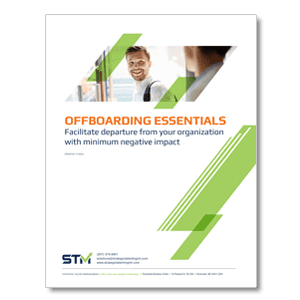Join STM’s Mailing List
Don’t miss any of our informative articles, news, or updates. Sign up to receive emails from STM today!
Onboarding and Offboarding: The Bookends of Employee Success and Organizational Health
In today’s hyper-competitive talent market, hiring the right people is just the beginning. What happens next—onboarding and eventually offboarding—is where organizations either strengthen or sabotage their workforce culture, productivity, and employer brand.
At Strategic Talent Management (STM), we partner with small to mid-sized businesses to solve people challenges holistically. From identifying top talent to guiding organizations through the critical first days—and final days—of an employee’s journey, we help companies design and implement structured, consistent, and human-centered talent strategies.
Let’s take a look at two often-overlooked, yet high-impact processes: onboarding and offboarding. Together, these stages bookend the employee lifecycle and form the foundation of sustainable organizational health.
Why Onboarding Matters: Getting It Right from Day One
“A person who feels appreciated will always do more than is expected.”
– STM Onboarding Essentials
According to Bersin research, 22% of turnover happens in the first 45 days. The implication is clear: onboarding is not just an administrative process—it’s your first real test as an employer. Your onboarding program must be intentional, integrated, and immersive.
What Makes Onboarding Effective?
STM defines effective onboarding as a process that begins at the offer stage and continues through the first year. It’s not just about policies and paperwork, it’s about aligning expectations, introducing culture, building trust, and accelerating productivity.
Here are the essential elements of a high-performance onboarding program:
- Preboarding Planning: Confirm start dates, send documentation, prep workspaces, and assign mentors before day one.
- Cultural Immersion: Introduce new hires to your mission, values, and goals, not just tasks and tools.
- Structured Check-ins: Weekly 1:1 meetings with supervisors and mentors are crucial during the first 90 days.
- Performance Milestones: STM recommends 30-, 60-, and 90-day reviews tied to measurable expectations.
- Ongoing Engagement: Real onboarding continues beyond 90 days with performance feedback, professional development, and recognition.
Companies with robust onboarding programs retain 91% of first-year hires and see productivity gains up to two months faster (Wynhurst Group, Texas Instruments studies).
Onboarding Remote or Hybrid Workers: A New Imperative
The post-pandemic workforce is dispersed. STM equips businesses to onboard remote and hybrid employees just as effectively as in-person hires. With customized checklists and culture-first strategies, companies can foster belonging and clarity, regardless of location.
STM’s Remote Onboarding Checklist Highlights:
- Ship equipment and welcome packages in advance.
- Set up virtual access to systems, files, and communication tools.
- Introduce mentors and colleagues via video call.
- Schedule virtual team lunches or coffee chats.
- Use performance tracking dashboards to measure early progress.
The Cost of a Poor Onboarding Experience
Lackluster onboarding contributes to higher turnover, disengagement, and reputational damage. When a new hire feels ignored or overwhelmed, their likelihood of becoming a long-term contributor drops significantly.
STM’s onboarding framework helps you avoid these pitfalls, ensuring new employees feel valued, prepared, and aligned from day one.
Why Offboarding is Just as Strategic
“While onboarding builds the foundation, offboarding defines your legacy.”
– STM Offboarding Essentials
Just as first impressions matter, so do final ones. Offboarding isn’t just logistics, it’s a final branding moment. Whether an employee leaves voluntarily or not, how you handle their exit effects morale, reputation, and even legal compliance.
Seven Steps to a Successful Offboarding Process
STM recommends a structured approach to offboarding:
- Communicate Transparently: Notify teams with clarity and professionalism.
- Manage Knowledge Transfer: Identify transition owners and schedule handoffs.
- Process Paperwork Thoroughly: Ensure payroll, PTO payouts, and benefits termination are cleanly handled.
- Conduct a Strategic Exit Interview: Use third parties or neutral managers to gather honest feedback.
- Reclaim Assets and Revoke Access: Phones, laptops, keys, credentials—secure it all.
- Acknowledge Contributions: Celebrate the employee’s impact, even in involuntary cases.
- Keep the Door Open: For high performers, consider future rehiring, referrals, or testimonials.
How Offboarding Protects Your Employer Brand
Poor offboarding can lead to bitter Glassdoor reviews, legal disputes, and fractured team morale. STM helps organizations make every departure as graceful and brand-positive as possible, ensuring that even exiting employees remain ambassadors for your company.
Using Offboarding Data to Improve Recruitment
Exit interviews are treasure troves of insight. By identifying patterns in why employees leave—especially top performers—you enable leaders to fix root causes, improve manager performance, and enhance the employee experience.
Sample questions from STM’s Exit Interview Toolkit:
- What prompted your decision to leave?
- Did the job match your expectations?
- What would have made you stay?
- How would you describe your manager’s leadership?
This data fuels strategic decisions across recruitment, culture, and workforce planning.
The Missing Link: Onboarding, Offboarding, and Talent Strategy
When organizations view onboarding and offboarding as isolated events, they miss the opportunity to build a seamless employee lifecycle. STM’s integrated talent management approach treats every touchpoint as a brand moment, from first impression to final farewell.
Our hiring, onboarding, and offboarding solutions are tailored to your culture, industry, and business goals because great talent strategy doesn’t start or stop with a hire.
STM’s Promise: People-Focused, Business-Driven Solutions
We help you hire better. Onboard smarter. Exit gracefully.
Whether you’re navigating remote onboarding, scaling your team, reducing turnover, or managing transitions, STM delivers practical, proven solutions tailored to your challenges.
Let’s talk about solving your people problems before they become business problems.


